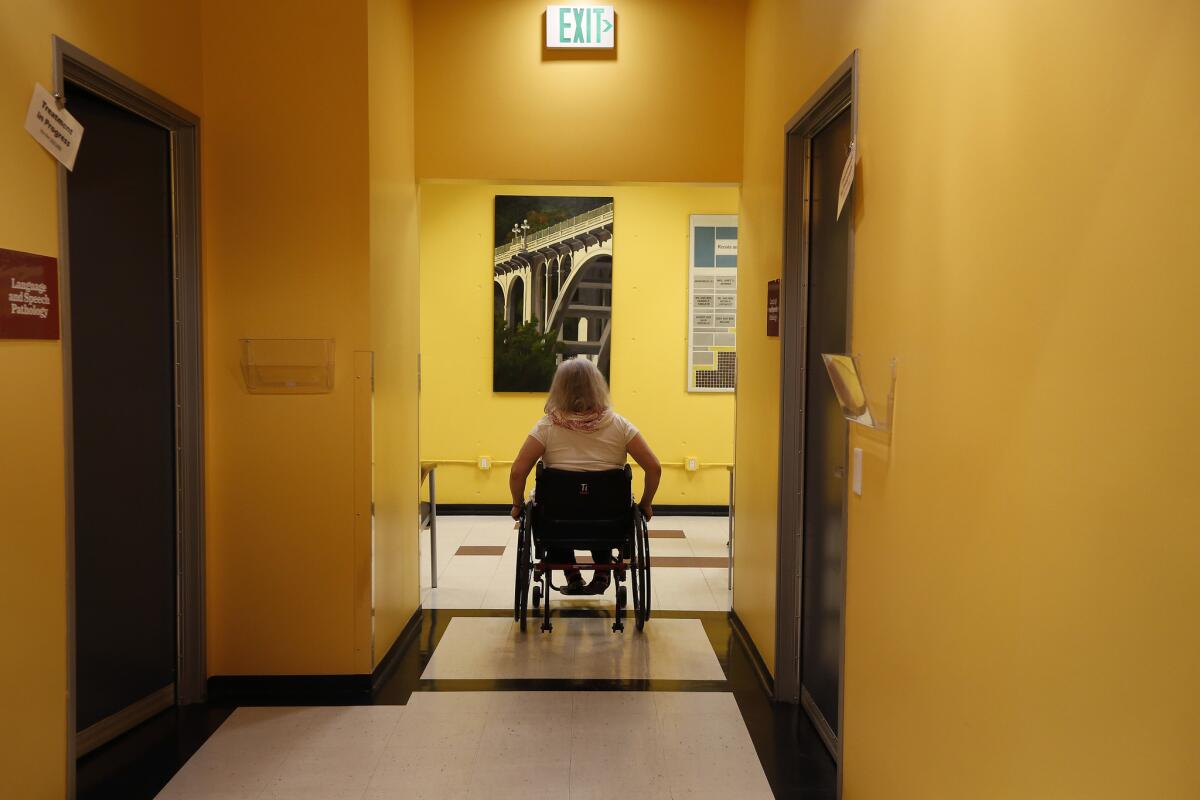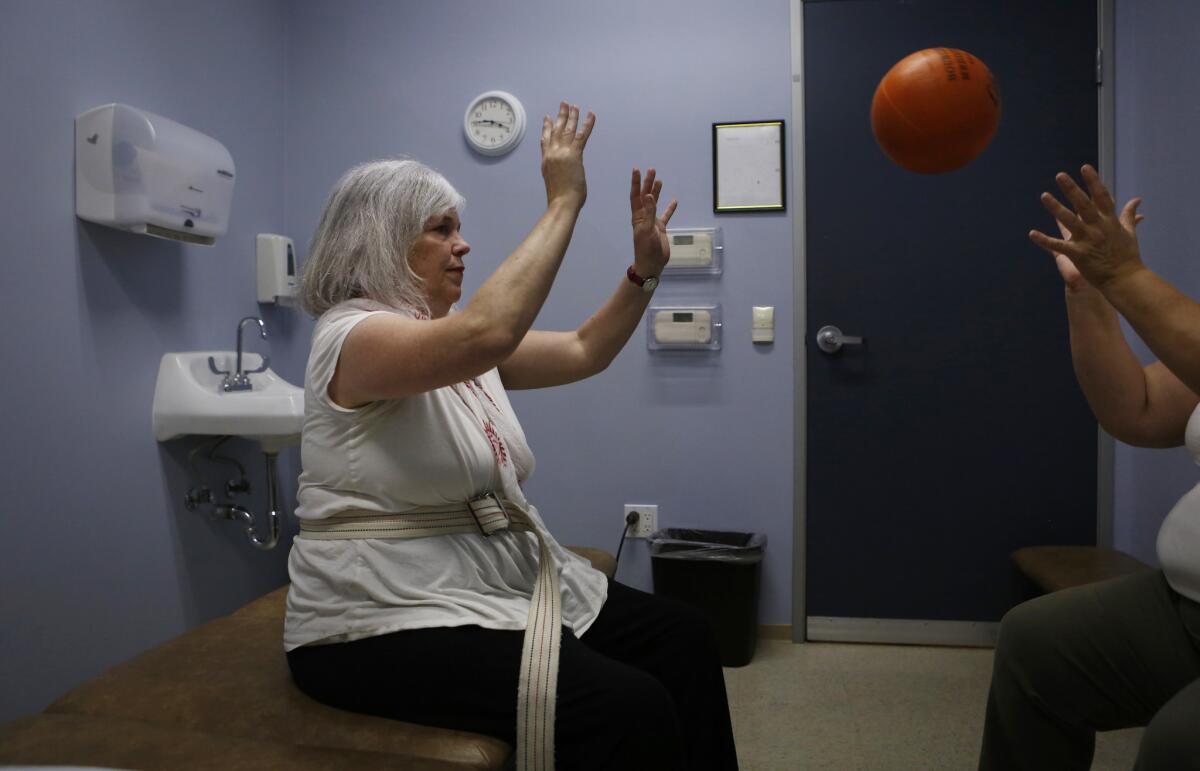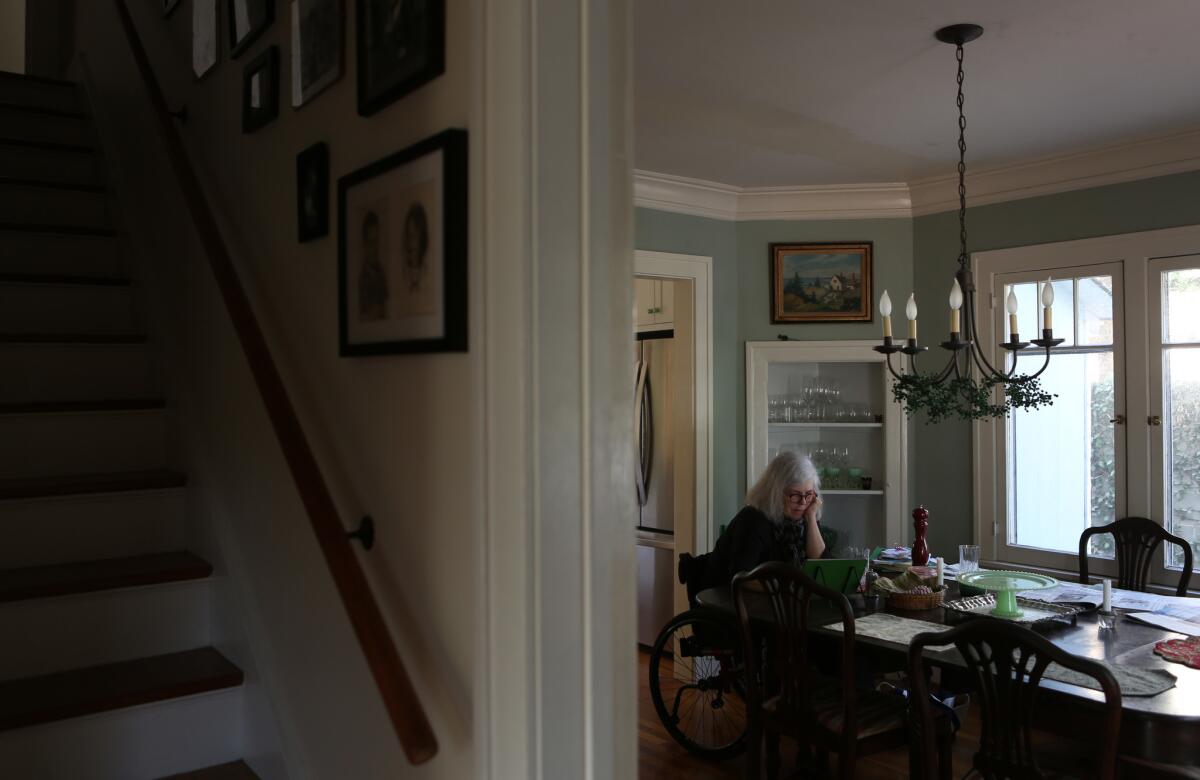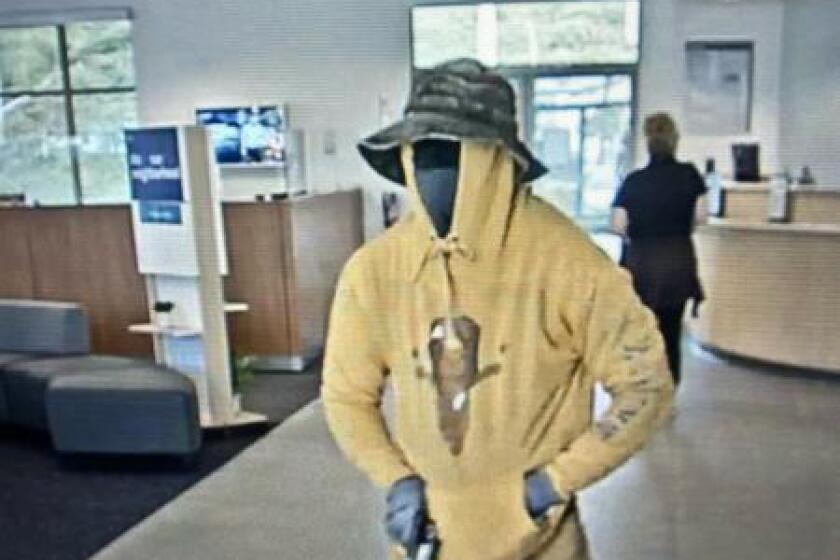How a mosquito bite led to paralysis — and turned this teacher’s life upside down

In September 2015, Missy Morris was diagnosed with West Nile Virus. She contracted the disease after being bitten by a mosquito in her Los Feliz neighborhood.
The virus rode inside the salivary glands of the mosquito as the insect flew crosswind over northeast Los Angeles in search of a blood meal. It was looking for a bird — a finch, sparrow or robin, the preferred targets — and it found Missy Morris.
Receptors on its antennae quivered at the hint of carbon dioxide, alcohols and fatty acids wafting off her skin, and the warmth of her body. The mosquito turned up wind, a course correction that would change Morris’ life.
During summers, she and her husband, Andy May, often ate dinner or took their morning coffees into the backyard of their Los Feliz home. They visited Barnsdall Park for outdoor movies, and at night they slept in an upstairs bedroom with open windows and missing screens.
“It’s like I was swimming with sharks,” Morris would later say.
Her predator, encountered in this sea of sky, was Culex quinquefasciatus, the Southern house mosquito. Other species live in the neighborhood — the Western encephalitis mosquito and the banded foul water mosquito — but Culex is the more common, the more insidious purveyor of West Nile virus.
It feeds at dawn and dusk, and the only giveaway is the high-pitched scraping of its wings.
Some mosquitoes nearly stand on their heads when they bite, but when Culex landed on Morris, it assumed a more parallel posture, pushing its long proboscis into her skin.
Four needles cut and retracted the flesh, a fifth lubricated the site with saliva, both anesthesia and anticoagulant. A sixth needle shivered and probed through a thin layer of fat to the network of venules and arterioles, each slightly larger than capillaries, that lie deeper in the epidermis.
Like any skilled phlebotomist, the mosquito pulled back with the first taste of Morris’ blood and started pumping, nearly motionless but for the occasional flicker of the abdomen as it filled with proteins needed to nourish its eggs (only females feed on blood).
Once full — ingesting more than twice its body weight — it withdrew and took flight.
What’s happened to me has pulled me into reality. I’m now part of humanity.”
— Missy Morris, West Nile virus survivor

Morris, 55, did not know she’d been bitten, but her body did. A small red welt rose on her skin, an everyday allergic reaction to the foreign proteins in the bug’s saliva.
For the last 11 months, health officials in the United States have focused on the spread of the Zika virus from Brazil, yet epidemiologists and vector control experts in California continue to be alarmed by the steady presence of the West Nile virus in Los Angeles and Orange counties.
For most of its short tenure in Southern California, West Nile has been a transitory epidemic, peaking every four years, in response to the rise and fall of the immune cycle of its primary host, birds that perch at night to sleep. Since 2014, however, the rates of disease transmission have run mostly unabated year after year.
In 2014, 218 cases were reported in Los Angeles County, and in 2015, 300 cases were reported.
About 80% of people infected with West Nile never know they have it. Their bodies fight off the infection. The rest develop a fever, and in less than 1% of these cases, the symptoms are more dire, especially for individuals older than 50.
Thirty-one fatalities were reported from West Nile in California in 2014 and 53 last year.
Discovered in North America in 1999 at the Bronx Zoo, the disease spread south and west across the continent in four years, a journey that had begun more than a half century ago in Uganda.
Like all viruses, West Nile is too small to carry the enzymes and proteins needed to replicate, so it steals the reproductive machinery of its hosts. Humans enter this cycle by accident when a mosquito, harboring West Nile, veers off course, bites someone and leaves behind its saliva.
Once under Morris’ skin, the virus began replicating. Smaller than bacteria, West Nile looks like a soccer ball with spikes. Its outer shell is a protein that allows it to slip inside a cell where it sheds its membrane and couples with the host’s RNA, forming new soccer balls that break out and begin their own replication process.
The epidermis provides temporary shelter, where the virus can lie undetected by the body’s defenses. White blood cells coast by without noticing anything amiss. This incubation period ends when the virus overpopulates this infection site and floods into the lymphatic system.
Following the tidal push and pull of Morris’ heart, the virus flowed throughout her blood stream. Her body tried to fight back, her immune system rushing to stop the assault, but its defenses, having never encountered this virus before, weren’t strong enough.
One Friday night, Morris came home feeling tired and achy, her temperature 103. The flu, she thought — the occupational hazard of anyone who works with children.

Within 24 hours, she was vomiting and had diarrhea, and a scrim had fallen between her and the world, as she later recalled.
May drove her to an urgent care facility in Pasadena. An intravenous solution of potassium and sodium cleared her head, but later, while walking back to her house, she froze. She wasn’t able to lift her legs, the neural impulse from the spinal cord failing to move the muscles. With her husband at her side, she shuffled into the downstairs den where she slept that night.
Viruses favor specific cells. Influenza likes the lungs and pulmonary system; hepatitis, the liver; and mumps, the parotid glands in the jaw. West Nile has a predilection for the nervous system.
As the millions of soccer balls swept through Morris’ organs, they brushed against the meninges, the lining that protects the brain and spinal cord. The cells here are among the most dense, a design intended to block invaders, but West Nile can break through this barrier by infiltrating the cells in the lining or hitching a ride on a blood cell. Researchers wish they knew more.
Inside Morris’ spinal fluid, the virus continued to replicate, destroying neurons as it burst out of the cells it entered. Her body began to mount a counterattack as dangerous as the assault.
The spleen, the immune system’s command center, began flooding her body with white corpuscles, lymphocytes. One class, B-cells, prepare a long-term defense, producing antibodies that can swarm the virus and prevent it from commandeering other cells, a process that takes up to 10 days. T-cells take more immediate action, swarming the sites of infection.
Morris’ blood vessels dilated. Her organs grew inflamed as plasma flowed to the infection and blood proteins enveloped the virus. The increase of fluids inside her skull raised the pressure upon her brain so that even healthy cells went haywire.
Morris was paralyzed. May wanted to take her back to urgent care, but she insisted that he take her lesson plan to school. When he returned, he called for a medical transport company.
By Monday afternoon she was disoriented, unable to answer the most basic questions: the day, her location, the president. She was admitted to the third-floor stroke center at Huntington Hospital. She drifted in and out of consciousness.
Medical staff drew blood and spinal fluid, tested for multiple sclerosis, bacterial meningitis, West Nile. Family and friends in masks, gowns and gloves waited bedside for the results.
May, who had left his job a few weeks earlier to become a real estate agent, kept notes.
Lots of activity but nothing conclusive yet…. We may have answers tomorrow.
For almost a week, tomorrow revealed nothing conclusive. Finally tests confirmed that she had West Nile.
I’m not too scared really; the possibility has been floating out there and now I can assign specifics and MOST people fully recover.
Two days later, he was less optimistic.
She cannot walk, and barely talks. There is no cure for the disease, she must regain her strength and spend weeks, maybe months in rehab. It has been scary. The world has changed in a profound way.
Morris’ body was clearing the infection. T-cells had become killer T-cells. B-cells were producing antibodies. Now she had to cope with the aftermath: inflammation of the brain, spinal cord and meninges, acute flaccid paralysis, neuropathy and tremors.

May transferred her into a skilled nursing facility. As he pushed her through the corridors, he sensed her fear and vulnerability. Lying in bed, battling the encephalitis, she drifted in and out of consciousness, unaware of what had happened. She saw people who weren’t there. She walked the hallways when no one was around.
Physical and occupational therapy took place in a group setting mornings and afternoons. Pushing a dowel through a wire maze was hard enough, walking impossible. The virus had destroyed the anterior horn cells in the lower half of her spine, without which the nerves to her legs were isolated from the brain.
Medications, especially a drug that eased the neuropathic pain, helped, and with strength returning to her arms, neck and torso, she transferred to an acute rehabilitation facility, a two-week boot camp to increase her independence.
By early December, she returned home. May had watched a YouTube video for building a wheelchair ramp, and in two hours, a sheet of plywood, reinforced by two-by-fours, covered the two 15-inch steps from the backyard into the kitchen.
He moved a hospital bed into the downstairs den and put a twin beside it for him.
Life is certainly better than the hospital but we face new challenges. Missy was a little sad with the realization that being home did not mean life as we knew it before.
Determined to return to the classroom, Morris reached out for support on Facebook. By the end of February, she was able to get to the bathroom by herself, no longer dependent on a bedpan. She cooked a meal almost without help, and she thought about suffering, even if it made her sad.
A mosquito and a virus had sent her life into a tailspin, affecting her husband, her children, friends and a classroom of kindergartners. Would anything be the same?
During the summer, the Los Angeles Unified School District spent $7,000 building wheelchair ramps and modifying thresholds at Ivanhoe Elementary School.
In August, Morris greeted 26 kindergartners from the perspective of her wheelchair. A new year had begun.

She misses what she had once taken for granted, going to the market by herself, leaving work when she wants to. Before getting bitten, life was sweet, she says and admits to being blissfully ignorant. Terrible things — accidents, illness — happen all the time, and she has come to accept her new life.
“What’s happened to me has pulled me into reality,” she says. “I’m now part of humanity.”
Winter is near, and Culex is still active in warm and moist places. Infection rates in L.A. County soared through August, but since then have tailed off. Currently 139 infections have been reported (with 16 fatalities statewide). Experts attribute the drop to lower temperatures and humidity.
Still Morris needn’t worry when she sits in her backyard. Her body is immunized against the virus. For visitors, a can of Off! Deep Woods with 25% DEET sits on the outdoors table between two wicker chairs.
The reporting for this article came from interviews with Missy Morris and Andy May; Dr. William Schaffner, professor of preventive medicine, Vanderbilt University; Dr. James Sejvar, neuroepidemiologist, Centers for Disease Control and Prevention; Dr. Mary Mioux Berry, physical medicine and rehabilitation; Susanne Kluh, scientific-technical services director, Greater Los Angeles County Vector Control District; Bruce Eldridge and John Edman, professors, department of entomology and nematology, UC Davis; Lark Coffey and Chris Barker, Davis Arbovirus Research and Training Lab, UC Davis; Mark Hovatter, chief facilities executive, LAUSD; and Lynda Rescia, principal, Ivanhoe Elementary School.
Twitter: @tcurwen
To read the article in Spanish, click here
ALSO
DWP tackles clean energy goals with new solar farms, low-income program
California’s top court will review major public pension ruling
Why your doctor might start grocery shopping with you
More to Read
Sign up for Essential California
The most important California stories and recommendations in your inbox every morning.
You may occasionally receive promotional content from the Los Angeles Times.











